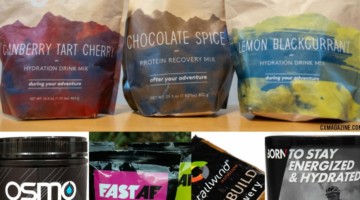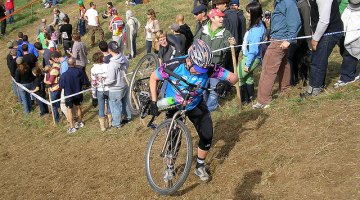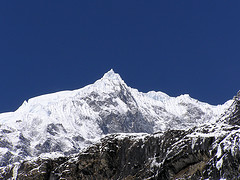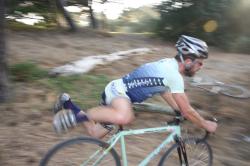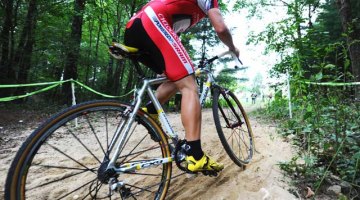by Chris Bagg
It takes about a week to get Santiago Lorenzo on the phone, and when I do, he doesn’t want to extrapolate about heat training. Lorenzo is a research scientist who, until recently, studied at the University of Oregon before picking up his PhD and moving to sunnier climates. He’s also an NCAA champion and 2004 Olympian in the decathlon, which means he’s a serious athlete. (Do you know the 10 events in the decathlon? I didn’t and went to look them up — anyone who can excel at all of them, and over only two days, knows a thing or two about getting the most out of one’s body.) He’s also published a study about heat training that may change the way we prepare for hot and cold events.
The article came out last October in the Journal of Applied Physiology, but hasn’t caused a huge stir in the athletic world. CyclingNews ran an abstract and the New York Times “Phys Ed” blog published a story. The underwhelming attention is odd, since Lorenzo’s study claims astonishing, doping-like numbers. Here’s the first paragraph of the study:
“This study examined the impact of heat acclimation on improving exercise performance in cool and hot environments. Twelve trained cyclists performed tests of maximal aerobic power (Vo2max), time-trial performance, and lactate threshold, in both cool (13° C, 30% relative humidity) and hot (38° C, 30% RH) environments before and after a 10-day heat acclimation program … Heat acclimation increased Vo2max by 5% in cool and by 8% in hot conditions. Heat acclimation improved time-trial performance by 6% in cool and by 8% in hot conditions. Heat acclimation increased power output at lactate threshold by 5% in cool and by 5% in hot conditions. Heat acclimation increased plasma volume 6.5% and maximal cardiac output 9.1% and 4.5% in cool and hot conditions respectively … These data demonstrate that heat acclimation improves aerobic exercise performance in temperate-cool conditions and provide the scientific basis for employing heat acclimation to augment physical training programs.”
If you were able to stick with the science-ese there, you’re probably doing the math to figure out what 5-8% improvements to your Vo2max , time-trial performance, and power output at lactate threshold would do to your racing performance. As an example, my threshold power is 339 watts. After the ten day program outlined in the study, I could expect new threshold numbers of 356 and 366 in cold and hot conditions, respectively. That’s not the difference between moving up a few spots at your local race — that’s the difference of moving up an entire category. By now you’re probably just scrolling down to see what the program was, so I’ll hop to it.
The study put a test group through this ten day program on top of their regular training, not in lieu of their regular training (a control group just continued with regular training). Test subjects pedaled at 50% of Vo2max for a total of 90 minutes in a 40° C (100° F), 30% relative humidity chamber. The test group took a short ten minute break at 45 minutes. Lorenzo and the other study authors chose 50% of Vo2max, a very easy pace, because it was a significant enough level of effort to induce heat stress, but not high enough to induce training adaptations. “The adaptations for training in the heat, for the heat are robust and well-known,” Lorenzo tells me. “But I wanted to see if you could pick up some advantage in the cold, as well.”
The study also monitored maintenance of the adaptations, and Lorenzo says you can expect to retain “about 95% of the benefit for about two weeks. People who are fit maintain the adaptations longer, and chronic dehydration will make you lose the benefit.”
Before you run to your bathroom to set up an ersatz environment chamber, Lorenzo cites a few caveats (remember that unwillingness to extrapolate?): “I can’t make any recommendation about replicating this study at home,” he says. During the study, test subjects had their core temperatures monitored “using continuous recordings of a rectal thermometer inserted 10cm beyond the anal sphincter,” and Lorenzo says that this kind of training can be dangerous if not properly monitored. So unless you have a very, very close friend, you should proceed with caution. “The adaptation comes from increased core body temperature,” Lorenzo says. “So anything you do to get that core temperature up, you’ll see some acclimation.” (I’d asked him if the temperature of the room was crucial, or if you could see some benefit from layering up like crazy and riding in your basement.)
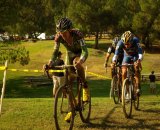
Here, Tyler Wren and Danny Summerhill struggled in the heat at Krosstoberfest 2010. Would heat training help them? © Kenneth Kill, Light & Shadows
The adaptations, in the scientific realm, come from being able “to thermo-regulate better. You sweat more, and you sweat sooner. That allows you to keep your body cooler. Your blood volume increases; plasma volume increases. Your cardiac output goes up. Your blood flow to either your skin, which cools you and lets you exercise longer at a given intensity, or your muscles, which let you exercise at a higher intensity, increases.”
On a final, pertinent note, Lorenzo told me that just after the study, one of the subjects went off and won his first professional ’cross race in warm conditions. He couldn’t give me his name, due to privacy concerns, but if that athlete is a reader of Cyclocross Magazine, he should contact us about being featured in the article we’re working on for our print magazine, delving further into the concept of “train hot — go fast cold” racing. In the upcoming issue #13, we’ll look at whether — and when — a cyclocross athlete would want to apply these training techniques, and how to do it effectively.
Journal of Applied Physiology, Volume 109 October 2010
























